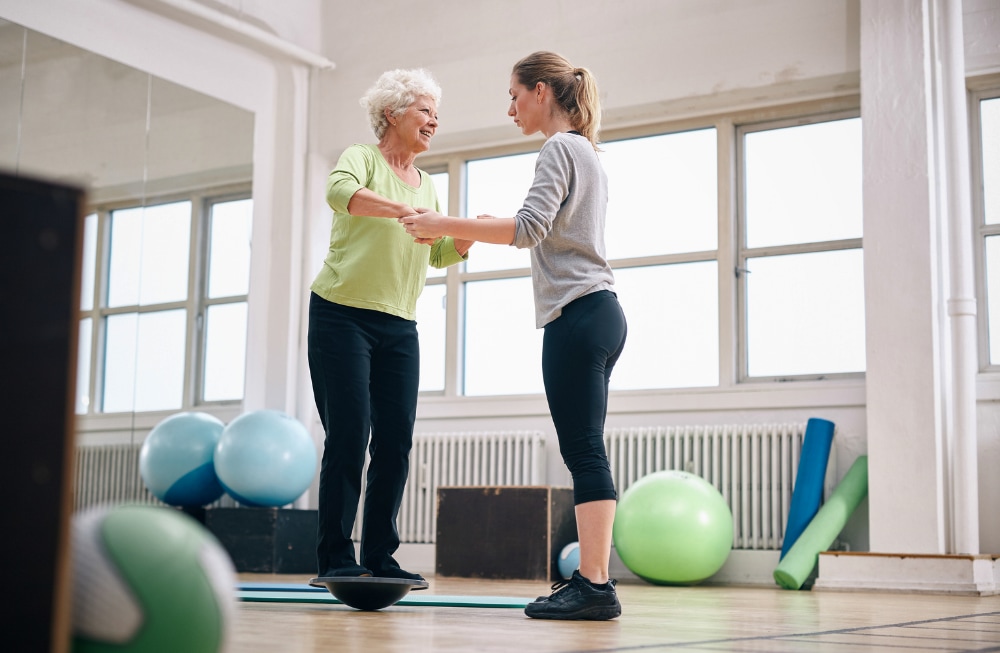Blog
Fall Prevention for Seniors: Essential Tips for Balance and Stability

Falls are a leading concern for older adults, significantly affecting independence and quality of life. Yet, fall prevention for seniors is achievable. With the right strategies, exercise and daily habits, seniors can maintain stability, reduce the risk of falls and enjoy a higher quality of life.
Communities like The Cedars and the UNC Wellness Center at Meadowmont provide valuable resources to support balance and fall prevention, helping seniors stay steady, active and confident in their day-to-day lives. Kate, who holds a nutrition and exercise science degree from Ohio State and is pursuing an advanced physical therapy degree at UNC-Chapel Hill, shares her expertise as a personal trainer at the Wellness Center on how seniors can take practical steps to prevent falls.
Why Fall Prevention Matters
“Falls can change someone’s life,” says Kate. She emphasizes that losing muscle strength, endurance and mobility can make recovery after a fall much more challenging. “A fall can mean a loss of autonomy. Suddenly, you might need a cane, walker or help with everyday tasks. The goal is to build strength and coordination before a fall happens, making it easier to maintain independence.”
The Role of Balance and Strength
Balance is more than staying upright — it’s having the strength, coordination and reflexes to react quickly to obstacles. As we age, our muscles weaken, and our reflexes may slow down, making it harder to recover if we lose footing. “Your ability to feel the ground beneath you and maintain stability is essential,” explains Kate. “Good balance helps ensure you don’t land awkwardly and fall.”
Key Factors Affecting Balance
Kate points out that balance is a combination of muscle strength, coordination and reflexes:
- Strength: “Everything drives one step after another. It allows you to get out of a chair, walk and reach. When you lose strength, you lose the ability to move freely.”
- Coordination: “Coordination is how your brain sequences your movements. When you walk, your arms swing naturally, and your feet follow a rhythm. Disruption in this pattern can make falls more likely.”
- Reflexes: “Slower reflexes mean less time to react to a potential trip, so staying active can help keep reflexes sharp.”
The Importance of Guided Balance Exercises
Regular physical activity is crucial for maintaining balance and preventing falls. Kate highlights the value of tailored exercises: “Balance training should always be approached with care, and it’s essential to consult your doctor before starting any new routine.”
At the UNC Wellness Center at Meadowmont, she often works with clients to develop personalized exercise plans focusing on core strength, coordination and balance. “Exercises like heel-to-toe walking, standing on one leg and seated marches can be very effective in supporting fall prevention for seniors, but they need to be done correctly and safely,” Kate explains. “A professional guide can ensure you get the most benefit while minimizing risk.”
Practical Tips for Fall Prevention for Seniors
Beyond exercise, these everyday practices can help with fall prevention for seniors, supporting balance and stability:
- Footwear Matters: “Wear shoes that fit well, offer good support and have a rubber sole. Avoid slippers or shoes with too much cushion, making you feel unstable.”
- Keep Your Environment Safe: “Ensure your home is free of tripping hazards like loose rugs and clutter. Small changes can make a big difference.”
- Stay Active: “Physical activity is key. It doesn’t have to be a gym workout; it could be vacuuming, playing pickleball or walking. As long as you’re moving, you’re maintaining your balance.”
Supporting Balance and Stability for Cedars Members
At The Cedars, we are committed to helping our Members maintain balance and stability. Our wellness programs are designed to support Members in staying steady and confident:
- Balance and Exercise Classes: Weekly classes focus on building strength, coordination and confidence. They provide a social and supportive environment for Members to improve their balance skills.
- Fall Risk Assessments: For those looking to take preventive steps, our wellness and rehabilitation teams offer personalized assessments to identify risk factors and suggest practical strategies to improve stability and reduce fall risk.
- Educational Workshops: Our informative sessions feature experts sharing tips on home safety, proper footwear and exercises promoting balance. These workshops also offer an excellent way for Members to connect with others and share their experiences.
The Benefits of Staying Active
Physical activity isn’t just about balance. “Being active improves your overall well-being,” Kate shares. “It boosts strength, keeps your reflexes sharp, and helps with coordination.” Whether through structured exercise or everyday activities, staying active ensures you can continue to do the things you love.
Programs at the Wellness Center
The Wellness Center at Meadowmont also offers resources to help seniors stay balanced and active:
- Exercise Classes: Designed to improve strength, coordination and confidence, these classes are tailored to older adults.
- Fall Risk Assessments: The team provides personalized assessments to help identify risks and suggest solutions during Fall Risk Awareness Week, typically in September. However, an assessment can be completed anytime if a Member requests it.
- Educational Workshops: Sessions on home safety, proper footwear and balance exercises.
- Personal Training: Personalized training sessions are available to Members and non-Members, offering tailored support for balance and overall fitness.
Staying Balanced for a Healthier, Safer Life
Falls don’t have to be a part of aging. Seniors can take control of their balance and stability by staying active, maintaining a safe environment and incorporating regular exercises. As Kate reminds us, “Strength training and movement are key. Start with small steps and build your way up. It’s never too late to make a difference.” For Cedars Members, wellness programs offer ongoing support, while both Members and non-Members can explore similar offerings at the Wellness Center at Meadowmont.